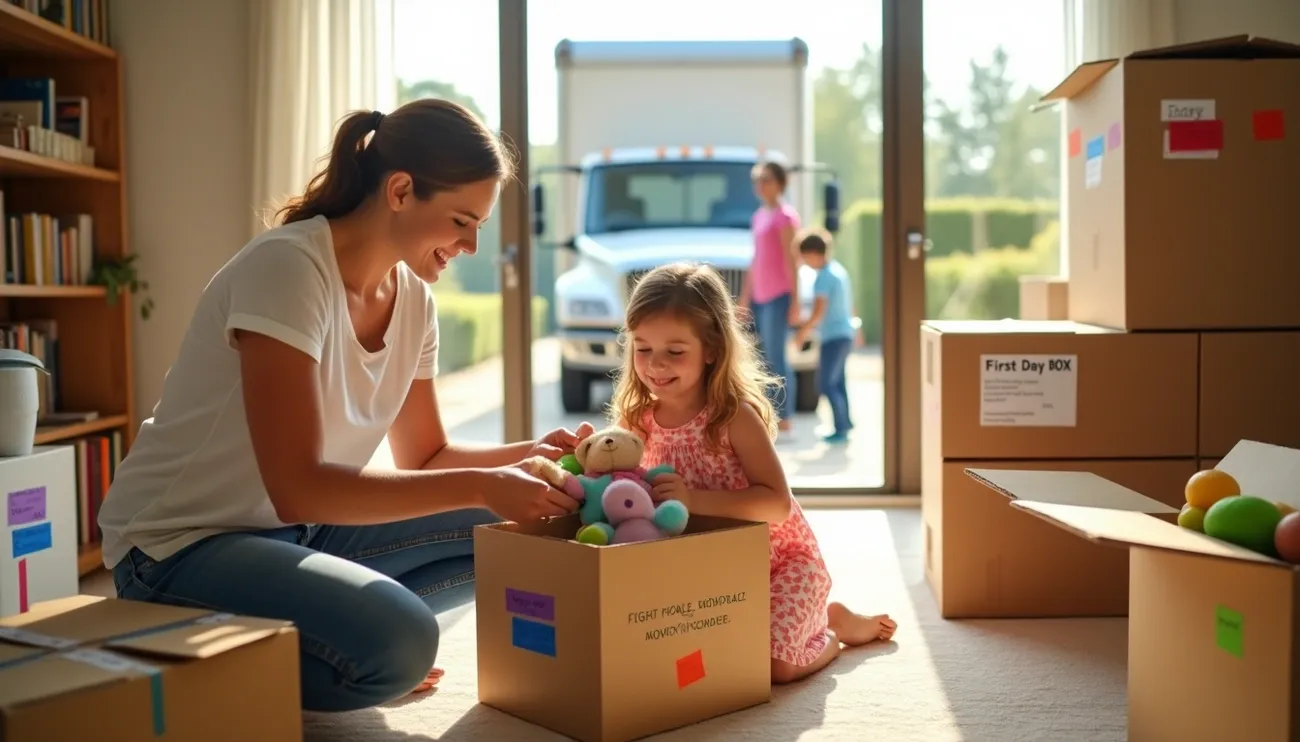Summer Moving Guide: Stress-Free Tips for Families with Kids
Intelligent moving tips can transform a chaotic family relocation into a smooth transition to your new home.

Intelligent moving tips can transform a chaotic family relocation into a smooth transition to your new home. Parents understand that moving with kids brings its own set of challenges, especially when you have school-age children who feel emotionally invested in the process.
Summer moves give families the most important advantages. Kids adapt better when they move at the school year's end. This timing helps them transition without disrupting their studies. On top of that, letting kids participate in the moving process builds their sense of control and excitement. They can pack their belongings and pick decorations for their new rooms. But parents should watch for behavior changes as kids adjust, and younger children will need extra comfort and support.
This piece shares proven ways to create a well-laid-out moving plan. Your children will feel supported through this big life change. We've put together everything from budget-friendly tips to packing essentials. These tools will help make your family's summer move stress-free.
Start Early: Planning Ahead for a Smooth Move
Your family's move starts several months before the big day. Early preparations lay the groundwork to make everything stress-free for parents and children. Let me walk you through the first steps to start this trip right.
Choose the right moving date with your kids
Summer gives families with school-aged children great advantages if they can pick their moving date. Kids can naturally say goodbye to friends as the school year ends and take time to settle in before starting their new school. Most moving companies say their peak season runs from May through early September because so many families move during this time.
Talk to your children about the move ahead of time. Last-minute announcements can create unnecessary stress and anxiety. Getting them involved at least eight weeks before moving day works best. Teenagers might adapt faster, but younger children need extra time because their sleep schedules and daily routines can get substantially disrupted during a move.
Create a realistic moving budget
A solid budget helps avoid financial stress during your move. Start by checking average moving costs in your area to set realistic goals. Your moving budget template should include:
- Transportation costs (moving company fees or truck rental)
- Packing materials and services
- Insurance coverage
- Extra fees (stair fees, specialty item handling)
- Post-move expenses (restocking, furniture assembly)
Building an emergency fund makes sense—experts suggest adding at least 20% to your estimated costs for surprises. Moving mid-week and mid-month can save money since prices are lower compared to weekends and month-end dates when leases typically expire.
Research and book a family-friendly moving company
Moving companies vary in how they handle family relocations. Look for movers who have solid experience with family moves. Good family-friendly moving companies know how to work safely around children and can adjust their services to fit your family's needs.
Check credentials carefully—interstate movers must have a U.S. DOT number and FMCSA registration. Local movers should be verified through your state's regulatory agency. Book your chosen moving company early, especially during summer when services are in high demand. This careful selection process helps ensure your belongings arrive safely and reduces stress on moving day.
Declutter and Pack with Purpose
A good declutter sets the foundation for any family move and turns an overwhelming task into something you can handle. You'll save countless hours and cut moving costs substantially by creating a clear plan before you pack your first box.
Sort and downsize room by room
The quickest way to tackle this job is to finish one room before starting another. "The benefit of tackling one room at a time is that you can better evaluate completion," notes professional organizer Nicole Gabai. Split your items into four groups: keep, donate, sell, and discard. The one-year rule works great here—you should probably let go of anything you haven't used in the last year.
Let kids help pack their own things
Kids feel better about moving when they're part of the process. Ask them what they really want to keep - their priorities might catch you off guard. "Children and grandchildren often want the things you least expected, such as a favorite holiday ornament or a knickknack that reminds them of a family trip," according to experts. Your children's involvement in sorting their stuff creates great chances to learn about responsibility and making decisions.
Label boxes clearly and color-code by room
Color-coding turns your packing system into a visual guide everyone can follow. Give each room its own color using colored tape or stickers on boxes. "Color coding can help you keep track of which boxes belong to which family member or which boxes go in which room," making unpacking nowhere near as difficult. Put up copies of your master color guide at entry points in your new home so movers know where each box should go.
Pack an essentials box for each child
Each child needs their own "open-first" box with immediate necessities. Pack it with comfort items like favorite stuffed animals, bedtime basics, hygiene products, and things to keep them entertained. Younger children's boxes should include diapers, formula, age-appropriate snacks, and a night light. These boxes should ride with you in your car—not on the moving truck—so you can reach them right away at your new home.
Moving Day Made Easy
Your moving day marks the peak of all your planning and preparation. These strategies will help you direct the day smoothly with less stress, now that your boxes are packed and plans are set.
Arrange childcare or fun distractions
Moving day creates many safety hazards for young children. Your best bet is to have childcare arranged away from home during the move. "Consider hiring a sitter to watch children while you work with movers to pack up your apartment," advises childcare experts. You could also ask trusted family members to help or check out drop-in daycare centers that take same-day bookings.
When childcare isn't an option, set up a special "kid zone" away from the action. A "moving day kit" packed with new toys, games, or activities will keep them busy. Your little ones might find moving day exciting instead of stressful with a tablet full of their favorite shows or a fun scavenger hunt.
Do a final walkthrough of your old home
A thorough check of your property before leaving makes sense. Look for items you might have missed in spots like medicine cabinets, under appliances, and inside built-in storage. Make sure all agreed-upon repairs are done and take photos of any new issues. This full picture helps prevent leaving treasured items behind.
Dress comfortably and stay hydrated
Moving day needs practical clothing. Go for:
- Comfortable, close-fitting clothes that won't catch on furniture
- Closed-toe shoes that support your ankles and give good grip
- Protective gloves to stop cuts and blisters
Your body can get dehydrated fast during a move, especially in summer. Water should be your constant companion—experts say to drink 7-10 ounces every 20-30 minutes when you're active. Sports drinks help replace lost electrolytes, and regular breaks in shaded or cool areas are essential.
Communicate clearly with your movers
The moving crew leader should have your contact details, and you should have theirs. Let them know about items that need special care right away. Most importantly, stay available to answer questions and give directions throughout the day. Good communication keeps everyone on the same page and gets your belongings safely to your new home.
Settling In and Helping Kids Adjust
The real challenge starts once you've unloaded the boxes - getting your family emotionally settled into your new space. Your children's adaptation to their changed environment largely depends on those first few weeks in a new home.
Unpack kids' rooms first
Your children need stability during this chaotic move. Setting up their bedrooms creates an immediate sense of normalcy. Kids feel unsettled when living in transition, and they need their own space to feel secure. Make their rooms your top priority before you tackle the kitchen or your own bedroom. Create a comforting sanctuary by setting up familiar items like bedding, stuffed animals, and wall decorations quickly. This approach helps your children feel more in control when everything else seems strange.
Explore the new neighborhood together
Your family should head out to find what your new community offers soon after arrival. This helps your children build positive connections with their surroundings. Here's what you can do:
- Walk or bike around the neighborhood to spot landmarks
- Visit local playgrounds where your kids might meet new friends
- Try nearby family-friendly restaurants
- Attend community events to connect with neighbors
These shared experiences help your children navigate their new world with confidence while creating lasting family memories.
Re-establish daily routines quickly
Your family needs structure whatever the moving chaos brings. Child development experts emphasize that younger children thrive on routine and predictability. Start by bringing back regular mealtimes, bedtime rituals, and morning routines as soon as you can. These consistent touchpoints show your children that family life stays stable and secure, even with boxes still waiting to be unpacked.
Help kids stay in touch with old friends
Your children need to maintain connections with their former friends. This reminds them that moving doesn't mean losing important relationships. Technology makes staying connected easier than ever - set up regular video calls, help younger children write weekly emails or letters, or create digital photo diaries to share. Plan future visits that give your kids something exciting to look forward to. This balanced approach helps your children keep meaningful friendships while making room for new ones.
Final Breakdown
Moving with children brings unique challenges, but good planning can turn this stressful experience into a chance for family growth. Starting preparations early gives everyone time to process the emotional changes while handling practical tasks step by step. A thorough decluttering process cuts moving costs and teaches children valuable lessons about what matters most.
Your moving day runs smoothly with kid-friendly activities and open communication with the moving team. The next step involves helping children adapt by quickly setting up familiar spaces and learning about your new community together. Kids adapt well when they feel part of the process and see their parents handle changes with confidence.
The adjustment takes time for everyone. Some days might feel overwhelming, while others bring unexpected joys as you find your new home's charm together. Keeping consistent routines helps while leaving room for new traditions. Soon enough, your new surroundings will feel like home and become the perfect setting for your family's next chapter. A thoughtful approach to this summer move creates positive memories instead of stressful ones and sets everyone up for a successful transition.
FAQs
Q1. How far in advance should I start planning a move with kids? It's best to start planning at least 8 weeks before your moving date. This gives you ample time to prepare your children, organize your belongings, and book necessary services. Early planning helps reduce stress and allows for a smoother transition for the whole family.
Q2. What's the best way to involve children in the moving process? Involve kids by letting them pack their own belongings, choose decorations for their new rooms, and participate in decluttering. This involvement gives them a sense of control and excitement about the move. You can also create special "moving day kits" with new toys or activities to keep them engaged during the actual move.
Q3. How can I help my children adjust to their new home? Focus on setting up your children's rooms first to provide immediate stability. Explore the new neighborhood together, visiting local parks and community spots. Quickly re-establish daily routines like mealtimes and bedtimes. Also, help kids stay in touch with old friends through video calls or letters while encouraging them to make new connections.
Q4. What should I pack in an "essentials box" for each child? An essentials box for each child should contain comfort items like favorite stuffed animals, bedtime necessities, hygiene products, and some entertainment options. For younger children, include items such as diapers, formula, age-appropriate snacks, and a night light. Keep these boxes with you during the move for easy access upon arrival.
Q5. How can I make moving day easier with young children? Consider arranging childcare away from home on moving day, or create a designated "kid zone" with activities to keep them occupied. Dress everyone in comfortable, practical clothing and stay hydrated throughout the day. Communicate clearly with your movers about any special requirements, and do a final walkthrough of your old home to ensure nothing is left behind.

